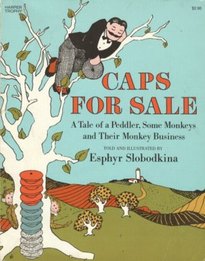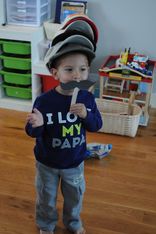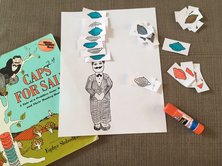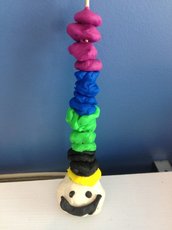If you read books with your child you have probably noticed they like to read the same ones again and again (…and again and again). Repetition is beneficial to helping children learn; however, it can get boring for the adults in their life. There are many activities you can do that are related to your child’s favorite books. Not only will these activities further develop your child’s language skills, critical thinking abilities and concept knowledge, it can also help maintain your sanity and put a new spin on things. This post is specifically for the book Caps For Sale (don’t worry, we’ll have other books coming up in future posts!).

What you can do while you read the book with your child:
Take advantage of this book’s repetitive nature with these ideas, which help build your child’s recall and sequencing skills:
- Once your child is more familiar with the book you can encourage them to participate in saying with you, “Caps! Caps for sale! Fifty cents a cap!” You can also see if when you start the sentence, can your child finish it? Can they eventually repeat the whole sentence on their own each time it comes up in the book?
- There are a lot of actions in this book. For example the peddler shakes his finger and fist and even stamps his feet. Act these actions out and encourage your child to imitate you.
- The monkeys have a part to play too! Have your child act like a monkey in the book when they are imitating the peddler’s actions.
- When you finish the story work on sequencing skills by having your child tell you the order in which the peddler stacks the caps. Go back through the book and use pictures if needed to help your child recall details in order to correctly sequence.
Questions you can ask as you read with your child:
Asking your child questions during or after a book is important to help build and strengthen comprehension skills, as well as, work on responding to different types of questions.
- WHAT questions (e.g., “What is the peddler doing?”; “What is the peddler’s job?”)
- WHO questions (e.g., “Who is selling caps?”; “Who took the caps?”)
- WHERE questions (e.g., “Where did the peddler rest?”; “Where are the caps?”)
- WHY questions (e.g., “Why did the peddler sit down?”; “Why is the peddler upset?”)
- HOW questions (e.g., “How do the monkeys get the caps?”; “How does the peddler get his caps back?”)
- PREDICTION questions (e.g., “What might happen while the peddler rests?”; “What will the peddler do next time he wants to rest?”)
- INFERENCING questions (e.g., “How does the peddler feel?”; “How can you tell the peddler is upset?”)
When your child works on answering questions about a story, it means they are building vocabulary and connections, as well as, critical thinking skills!
Fun activities to do after the book:
Doing activities related to a book you have read with your child is a great way to continue strengthening language skills. Incorporating activities related to a story help further build your child’s ability to make connections and associations, increase their vocabulary skills, and can also help with ability to recall and sequence information they have learned or been exposed to. You do not need to do all of these activities in one day. Feel free to spread them out over many days or weeks and even repeat them.



- Make a picture with the peddler and his caps: You can trace or copy a picture of the peddler with the caps on his head out of the book. Remove or omit the caps on his head. You can make caps (using colored paper) or cut them out if you made a copy of the page. Work on having your child glue the caps back on in the correct order. You can even try this with play-doh to change it up. ** (this activity is good for working on recall of details, sequencing, colors, counting, vocabulary of actions and nouns from the picture)
- Instead of Pin the Tail on the Donkey, play Pin the Cap on the Monkey: Make a monkey and some caps (or copy and enlarge pictures from the book) and play away. **(this activity is good for colors, counting and prepositions, i.e., locations, for where the caps end up– “The checkered cap is next to the monkey”, “A blue cap is under the monkey”, “Where is this red cap?”, “Can you find a cap that is below the monkey?”, etc)
- Pretend play: make a cap store and pretend to buy and sell hats. You can use dress-up clothes to be the seller and/or the buyer, pretend or real money, and any other accessories you can think of! **(this activity is good for working on pretend play skills, ideation, turn-taking, sharing, problem solving, and also can help reinforce vocabulary and concepts from the book)

As we discussed in this post, at The Speech Space we are huge fans of books. Not only are books a wonderful way to engage and spend time with your child, but they are also a great means for building language skills like vocabulary, critical thinking and problem-solving skills. Adding or incorporating fun activities related to books you read with your child can double the impact (and fun!).
Check back on the blog for more ideas and activities you can do with your child to help encourage their communication development. If you have questions or concerns about your child’s s development, contact us at The Speech Space. We offer free screenings, which take approximately 30 minutes, and can help identify potential problems.
